Two electric sailplanes come from different ends of the soaring spectrum and each shows its own unique character. Their differences are as noteworthy as their geographic separation.
Birdy
Birdy is a single-seat, electrically powered motor glider that fits the European Union 120 kilogram class. The 264-pound empty weight puts it 10 pounds above America’s FAA Part 103 254-pound limit. But Euro craft in that category are not as limited in top or cruise speed.
Birdy’s light weight required clever arrangement of components to enable a maximum takeoff weight of 280 kilograms (616 pounds) and pilots up to 1.95 meters (6’ 5”) tall. Its 13.5-meter (44.29-foot) wingspan carries only 13.9 pounds per foot, enabling 40:1 glide ratio at around 90 kilometers per hour (55.8 mph). Its 8.3 square meter (89.3 square foot) wing area lifts only 6.89 pounds per square foot, enabling a 63 km/hr (39 mph) stall speed with flaps. Birdy can top out at 180 km/hr (111.6 mph), well above FAA ultralight constraints. Since it’s a sailplane, that may not count here.
It can operate in a highly independent way, able to take off on its own power and capable of being recharged by its “optional trailer with photovoltaic modules, [and] does not require any other infrastructure or auxiliary personnel other than a take-off and landing field.”
The maker explains, “The CFRP / GFRP structural components are manufactured by the German aviation company Klenhart-DESIGN and partner companies in NC-milled GFRP molds from the most suitable composite materials in order to achieve high overload capacity, practical surface robustness and still low empty weight. Hans-Peter Schneider (Technical Director of the DVLL, experienced aircraft manufacturer and approval expert) is responsible for the independent quality assurance of production.”
Lightweight, High-Torque Electric Power
An Eck-Geiger electric drive in the area of the center of gravity with 12 kW or 16 kW continuous-power motor drives the removable, folding 1.3-meter (4.27-foot) propeller through a long shaft. This type of drive starts immediately when required, does not require motor extension or retraction “and avoids the otherwise unavoidable, strong increase in aerodynamic drag in motorized cruise flight.”
Three potential motors from company’s selections have rather amazing specifications.
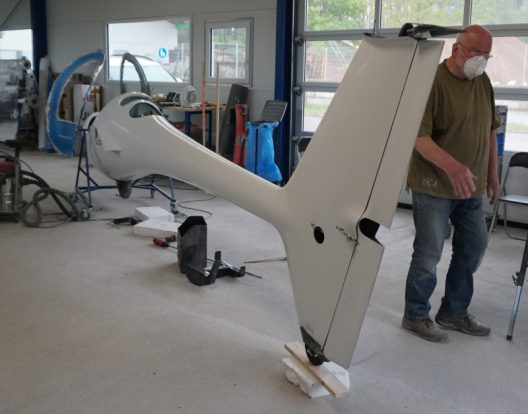
Where the power comes out. Birdy has a centrally-mounted motor and batteries, with a folding propeller on the tail
The HPD12 produces 12kW continuously and /15kW peak from a weight of only 3.75 kilograms (8.25 pounds). Turning over at a leisurely 2,180 rpm, these little disks can spin a fairly large propeller slowly and still produce substantial thrust.
The slightly larger, 4.7-kg (10.34-pound) HPD16 puts out 16 kW continuously and 20 kW at peak at 2,280 rpm. For the same weight, the HPD20SD generates 20kW continuously and 25 kW peak at 2,600 rpm. All of them use an MC300 Motor Management System which can pass 300 Amperes of current continuously, 400 Amps for approximately three minutes, and 600 Amps for around 30 seconds.
Enough Energy to Have Some Real Fun
Birdy can carry single or dual Geiger battery packs of three kilowatt-hours or six kWh enabling ranges of more than 200 kilometers in pure powered flight. Each battery pack holds 3.6 kW-hr of energy and has its own battery management system (BMS) to enable monitoring and optimal charging. A possible range extender could increase endurance “almost at will in the future.”
Since Birdy can maintain level flight at about 80 to 90 kilometers per hour (49.6 to 55.8 mph) on a mere 3 kW (4 hp), even a single battery pack will allow some thermal hopping and safe returns to the pilot’s home field. A rate of climb of three meters per second (590 feet per minute) should require full power for only a few minutes, leaving a reasonable “cruising” range.
A brochure in German highlights the little sailplane’s features.
120-Kg Aircraft
In Europe, Airplanes up to an empty weight of 120 kg allow for de-regulated and easy flying. Pilots need a sports pilot license, but no medical certificate. With access to a runway or field, a Birdy pilot can have the sky to him or herself, and search for adventures in “green air,” sailplane pilots’ lingo for rising air.
Jonkers JS-3 RES
Far larger, faster, and heavier, the JS-3 RES (Retractable Electric power System) from South Africa’s Jonker Aircraft puts its pilot in full competition mode. The company notes they are a relative newcomer to the ambitious high-performance sailplane world, with three major competitors sharing the world market for decades. When the Glaser-Dirks DG-400 took to the skies, extreme motor-gliding became a reality, and others have taken on the challenge. Jonker started a decade ago with their JS-1 Revelation (now with over 100 sales), and has reached the JS-4 – due for flight testing soon.
We will focus on the JS-3 here, with its Slovenian Emrax 188 motor, a Roman Susnik design that produces 40 kW maximum and 25 kW continuously for climbing. This allows self-launching, although a ground handler or two might be necessary because of the JS-3’s 15-meter to 18-meter wingspan. Only 188 millimeters (7.4 inches) in diameter and 77 mm (3.03 inches) thick, the motor weighs a mere seven kilograms (15.4 pounds). Axial-flux motors in the Birdy and the JS-3 show a dramatically light weight for the power and torque they produce.
SOLO Aircraft Engines, well known for their two-stroke gasoline engines, helped design the electric power system on the JS-3. They aimed to contain the retracted propeller, motor and mast within the “smallest possible modern fuselage”. To enable self-launching, battery capacity was set at 9.4 kWh running at 400 Volts, and a large, efficient propeller “was matched with the motor torque curves to minimize losses.”Two battery packs weigh 22 kilograms each, and have standalone battery management systems much like those on Birdy. Internal current sensors and fuses help prevent thermal runaways and the ever-inconvenient smoke release.
Buyers can have a “pure” JS-3 with no additional power system, and use all their skills to ensure a safe trip to a planned destination. Or they can choose from an MD-TJ 42 jet sustainer system , or the Solo electric sustainer/self-launch system.
The Emrax motor drives a two-bladed, 1.2-meter (3.94-foot) propeller the can produce up to 90 daN (90 decaNewtons =202.3 pounds of force). The retractable part of the system weighs 21 kilograms (46.3 pounds) and can get the 500 kilogram (maximum takeoff weight) craft off the ground in 500 meters (1,640 feet) and establish a rate of climb of 2. 3 meters per second (453 feet per minute). Note the heavier craft, even with more power, climbs more slowly than Birdy. Still, it reaches 500 meters, 1,640 foot) altitude having used only 2.5 kWh from its battery pack.
The JS-3 can fly in standard class with 15-meter (49.2-foot) wings. Or with longer wingtips that give an 18-meter (59-foot) span. In 15-meter configuration, the JS-3 has a 50:1 glide ratio, slipping forward 50 feet for every foot it loses in altitude. It drops only 104 feet every minute. If the plane is one mile high, it would take over 50 minutes to touch down. With the 18-meter tips, the glide ratio goes up to 56:1 and the rate of sink sinks to 94 feet per minute, giving over 56 minutes of flight before reaching the ground.
Powered Sailplanes – a Great Proposition
With the potential to take one flying in the cleanest possible way, and promising high performance on small power, Bird and the JS-3 show what can be done within the limits of today’s batteries. Imagine what their future can be as energy storage matures.

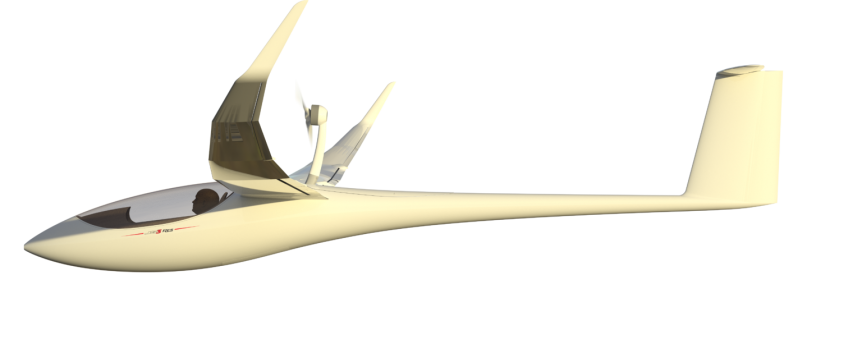

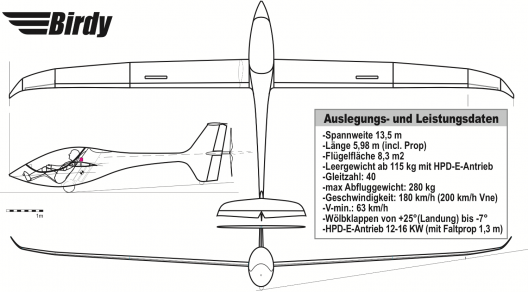
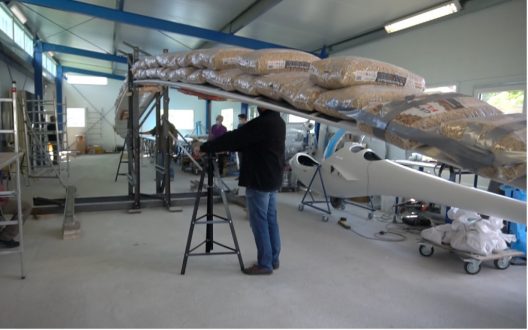
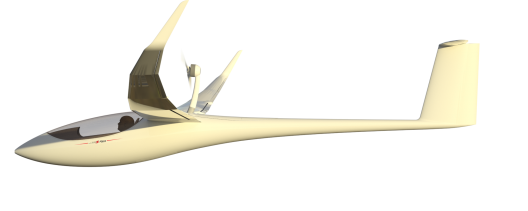
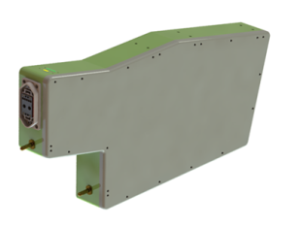
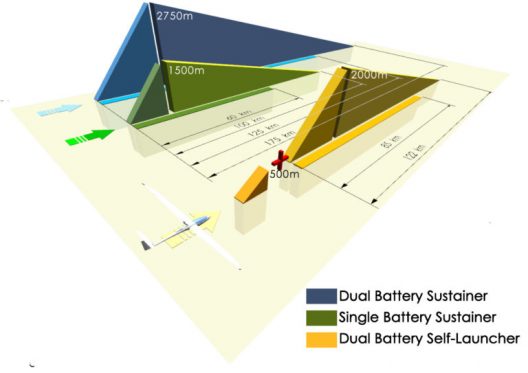
Comments 6
What is the price of the birds? Who do I make contact with? Looks like fantastic fun aircraft.
Has anyone done a decent report on the 120kg Birdy in English?
Regards,
Hugh
Regarding the Birdy motorglider; Please provide cost in U.S. dollars delivered to U.S. What is useful load? Is the glide ratio really 40/1. Thank you.
Kindest regards, Matthew Poleski
Author
Look at the Birdy home page for contact information. There is an email form to fill out to gather pricing, etc. Hope you find a happy ending to this!
https://e-birdy.com/
Author
Look at the Birdy home page for contact information. There is an email form to fill out to gather pricing, etc. Hope you find a happy ending to this!
https://e-birdy.com/
Author
Look at the Birdy home page for contact information. There is an email form to fill out to gather pricing, etc. Hope you find a happy ending to this!
https://e-birdy.com/